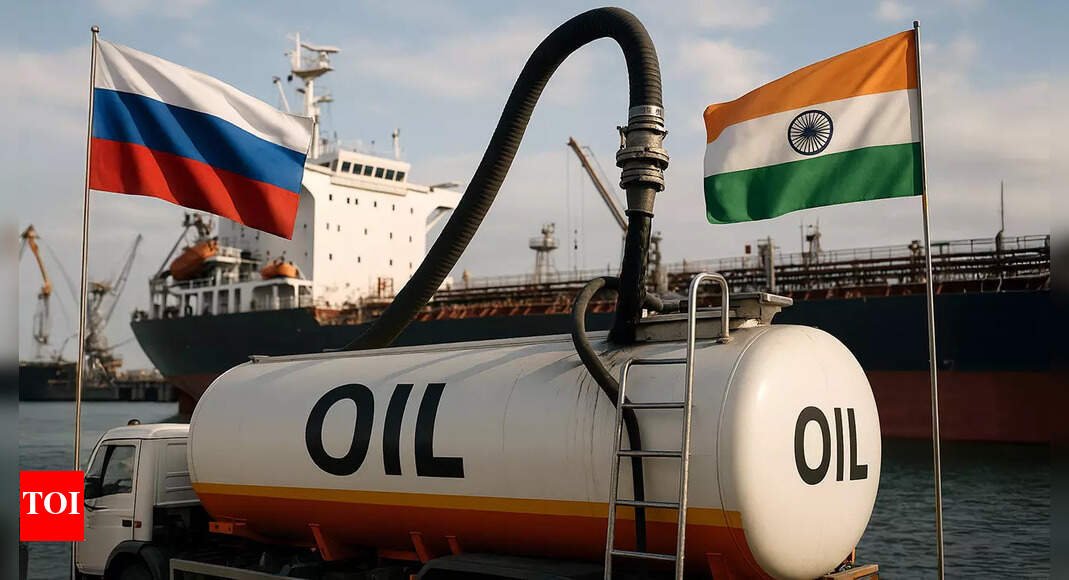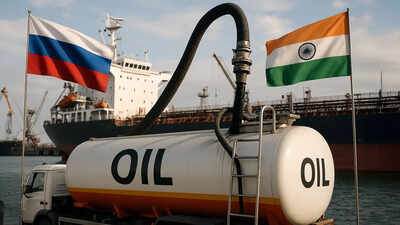Donald Trump has claimed assurance from PM Narendra Modi that India will stop buying Russian crude oil. Russia maintains its position as one of the world’s primary crude oil producers and exporters. While the Ministry of External Affairs has firmly denied knowledge of a call on this matter between the two leaders, it is important to note that stopping Russian crude imports is easier said than done.This situation has emerged as a central point of diplomatic and trade disagreement between India and the US. India faces 50% tariffs on its exports to the US, 25% of which is a penal tariff for its imports of Russia’s crude.
The significant dependence on Russian oil, which currently constitutes over one-third of the total crude processed in Indian refineries for producing fuels such as petrol and diesel, cannot be terminated suddenly, according to a PTI analysis. The most feasible option at present would be a gradual reduction in imports. We take a look at India’s oil trade, dependence on Russian crude & alternatives to it:
India’s oil trade with Russia & the world
- India, being the world’s third-largest oil-importing and consuming nation, heavily relies on imports to meet its crude oil needs, with 87 per cent of its approximately 5.5 million barrels per day consumption coming from overseas.
- Historically, India procured approximately 66 per cent of its crude oil requirements from Middle Eastern nations, primarily Iraq, Saudi Arabia and the UAE.
- Following Western sanctions on Moscow due to its war with Ukraine in February 2022, India began acquiring Russian oil at discounted prices, as Western nations avoided Russian supplies.
- The substantial price advantage was the key factor in India’s decision to purchase Russian oil. While discounts initially reached $19-20 per barrel in 2023, they have subsequently decreased to $3.5-5 per barrel.
- As a result, Russia’s contribution to India’s total oil imports rose significantly from 1.7 per cent in 2019-20 (FY20) to 40 per cent in 2023-24, establishing Russia as India’s main oil supplier.
- India’s Russian oil imports reached 88 million tonnes in FY25, a significant part of its total imports of 245 million tonnes.
Russian oil deliveries in early October reached 1.77 million bpd. Iraq secured the second position, supplying around 1.01 million bpd, with Saudi Arabia following at 8,30,000 bpd. The United States surpassed the UAE to become the fourth largest supplier, delivering 647,000 bpd. The UAE contributed 394,000 bpd.India’s crude imports during September reached approximately 4.7 million barrels per day, showing an increase of 2,20,000 bpd compared to the previous month whilst remaining constant year-on-year. Russia remained the main supplier, delivering about 1.6 million bpd, accounting for 34 per cent of total imports.According to preliminary data from global trade analytics firm Kpler quoted in the PTI report, this volume was approximately 1,60,000 bpd lower than the average Russian imports during the first eight months of 2025.Also read: India’s Russian crude oil trade rebound in October after previous quarter dip; imports rise to 1.8 million bpd
Why India can’t abruptly stop Russian oil imports
Stopping Russian crude oil immediately is a near impossible scenario, says the PTI analysis. Oil procurement operates on a 4-6 week advance contract basis, meaning current deliveries were arranged in early and mid-September.Contracts through November’s end are already established. Consequently, if Trump’s statement proves accurate, Indian refiners would cease new contracts, resulting in Russian deliveries potentially declining from late November.Based on existing contracts, analysts indicate that current Russian import levels of 1.6-1.8 million bpd appear “more realistic” for the upcoming weeks.India’s oil infrastructure continues to rely heavily on Russian crude. The substantial price advantages make it commercially advantageous for refiners to maintain these purchases. Though, notably these discounts have come down now.The economic rationale remains sound. Despite reduced discounts compared to 2023, Russian oil varieties, particularly Urals, continue to offer Indian refiners competitive advantages through favourable landed costs and superior GPW margin yields.Kpler’s analysis contradicts Trump’s assertion regarding India reducing Russian oil imports, viewing it as political rhetoric without official backing from New Delhi. The data shows steady flows and the reduced imports observed during July-September were primarily attributed to seasonal maintenance operations at PSU refineries rather than tariff-related concerns.Furthermore, the delivery contracts until early September were confirmed 6-10 weeks beforehand, indicating that July-September fluctuations were predominantly linked to refinery operational needs.
India’s openness to diversify & buy US energy
Data from Kpler suggests India’s potential US oil imports have an upper limit of 400,000-500,000 barrels per day. This ceiling exists because American crude grades present logistical difficulties, financial constraints, and compatibility issues with Indian refineries, making a substantial shift towards US oil improbable.Indian refineries’ efforts to expand their supply sources continue, seeking economically viable shipments. Kpler statistics indicate that India’s US crude imports reached 310,000 barrels per day in 2025, up from 199,000 barrels per day in 2024, with projections showing a peak of approximately 500,000 barrels per day (Expected in October).
What are India’s alternatives to Russian oil?
From a technical perspective, Indian refineries can function without Russian supplies, though this would necessitate significant economic and strategic adjustments, according to analysts.Russian crude provides superior distillate yields in the refining process. A transition away from Russian supplies would result in decreased middle distillate production (diesel and jet fuel) whilst increasing residue output.Russian crude’s high distillate yield capability aligns perfectly with India’s sophisticated refining systems. This has enabled state and private refiners to exceed normal capacity whilst maintaining profitable operations.A shift away from Russian oil could cost India an additional $3-5 billion yearly in import expenses (calculated at $5 per barrel premium on 1.6-1.8 million bpd), the PTI report says,The financial impact could escalate considerably if global prices increase, particularly in a scenario where Russian crude exports decline due to insufficient Indian purchasing.Sourcing alternatives for 1.6-1.8 million barrels per day of Russian crude would require diversified regional sourcing.The Middle East presents the most practical alternative, with American WTI Midland grades potentially contributing 2,00,000-4,00,000 bpd.US crude grades, being lighter, produce less diesel, which disadvantages India’s distillate-focused demand. Distance-related freight costs and logistics limit scalability. West African and Latin American crude offers limited potential.Also read: India cutting Russian oil imports by 50%? White House makes big claim; refiners await clarityAnalysts suggest an optimal replacement strategy might comprise 60-70 per cent Middle Eastern supplies, supplemented by American and African/Latin American crude as tactical alternatives.Russia maintains its position as a significant oil exporter, with its primary markets being China, India and Turkey. During September, Chinese purchases constituted 47 per cent of Russian crude exports, whilst India acquired 38 per cent, followed by Turkiye and the EU at 6 per cent each.Stopping of Russian oil imports would compel India to seek limited alternative sources, potentially causing global crude prices to escalate to $100 per barrel, amidst increasing demand and constrained supply.Industry experts indicate that crude oil resources are finite globally. The exclusion of a major supplier like Russia would necessitate importers, particularly India, to source from other providers. This shift in demand towards non-Russian oil would result in price increases, potentially triggering worldwide inflation.Russia’s exports range between 4.3-4.8 million bpd (from a total production of 9.2 million bpd), representing approximately 5 per cent of global crude oil supply.India has successfully controlled inflation by maintaining steady fuel rates recently. The strategy involved creating reserves through purchasing affordable Russian and other crude oils, enabling stable retail pump rates during international price surges, as witnessed in 2022.Whilst India’s shift towards Russian oil ensured affordable energy supplies, the Trump administration expressed criticism regarding these purchases, suggesting that New Delhi benefited from discounted Russian oil whilst exporting refined fuel to various regions, including Europe.India’s stance remains that its actions comply with international regulations, noting the absence of sanctions on Russian crude purchases. The European Union has only recently prohibited importing fuel derived from Russian crude. The US has not imposed restrictions on purchasing Russian crude oil or its refined products.Despite many EU countries prohibiting Russian oil imports, other nations must adhere to an established price cap when purchasing Russian crude oil. Indian imports have remained within this prescribed price cap.




